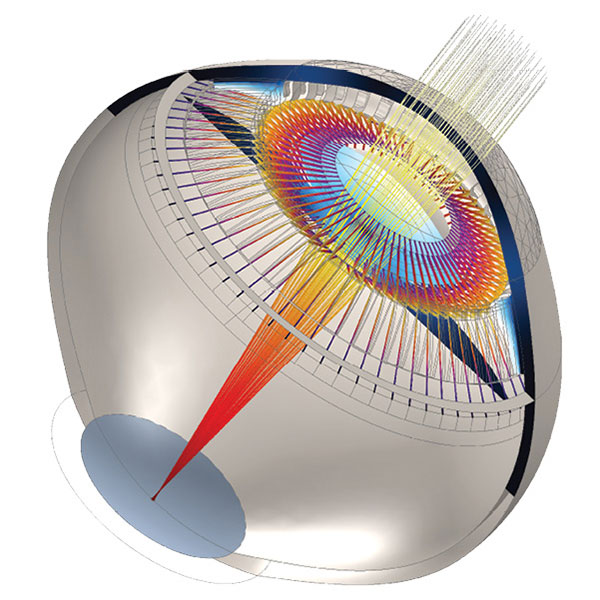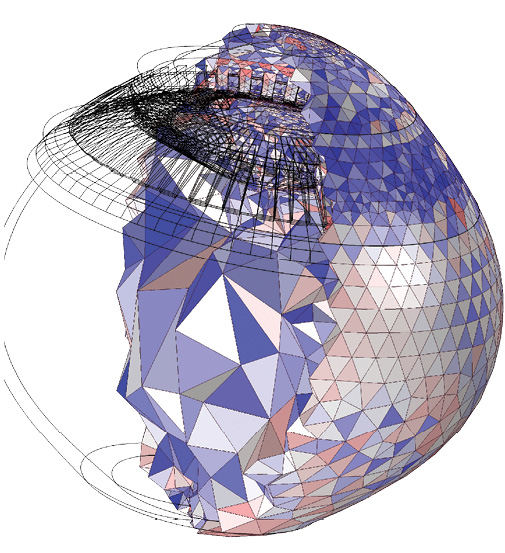
Kejako uses COMSOL Multiphysics modules to develop a parametric eye model to visualize the total displacement and ray trajectories, a way to simulate and understand presbyopia. Image courtesy of Kejako and COMSOL.
Latest News
January 31, 2019
Can the same finite element codes and solvers used to simulate car crashes and engine heat dissipation be used to model how we see things? This question was settled when a team of researchers from the Geneva, Switzerland-based startup Kejako, an ophthalmology solutions developer, decided to build a parametric model of the human eye and tackle something we all face as we grow old: loss of focus.
In a paper published and presented at COMSOL Conference 2017, hosted by multiphysics simulation software maker COMSOL, the researchers wrote: “Today in vivo imaging technologies do not allow to measure the eye components material properties such as the refractive index or the stiffness: These properties are essential to understand and diagnose the effect of aging on the eye’s accommodative performance and develop new surgeries. To address this problem, Kejako has set up a parametric 3D mechanical model of the human eye, in addition with an optical evaluation.”
One of the effects of aging is presbyopia, or the loss of near-focusing ability. It tends to occur in people over age 40, according to the eye resource site All About Vision. The parametric eye, the Kejako researchers suggest, can help develop and refine treatments of presbyopia or other eye disorders.
“We believe simulation can be a great and efficient tool to develop [an] innovative diagnosis method, based on indirect measurement of a physical value and reverse engineering. In fact that’s what we already did for the GRIN (Gradient of Refractive INdex) value. We’re eager to do the same for other values,” says Aurélien Maurer, Kejako’s R&D engineer and one of the paper’s authors.
Recreating the Eye in Pixels
The basic mechanics of the human eye are as follows: Light coming from an object enters the eye through the cornea, which functions like a window. Light propagates inside the aqueous humour, a liquid chamber behind the cornea. The clear disc-like lens helps focus the light on the retina. When the image is in focus, the image is sent to the brain for processing.
According to Kejako’s research, presbyopia is the result of aging-related crystalline lens stiffness, which affects the lens’ ability to adjust its radius of curvature to help keep things in focus.
Kejako has already built and validated a complete 3D non-axisymmetric model of the human eye. To account for the biomechanics of the different subcomponents of the eye, the team used COMSOL’s Multiphysics Nonlinear Structural Materials Module, Structural Mechanics Module and Ray Optics Module. “The model was proven ... to be able to simulate entirely the presbyopia progression—i.e., the progressive loss of vision with aging—when applying the age-related geometric and material changes,” write Kejako researchers.
The parametric optomechanical eye model, as Kejako calls it, is the next step. This involves the use of COMSOL Multiphysics’ CAD Import Module, Structural Module and Nonlinear Structural Materials Model. To model how the retina works, users deploy the Ray Optics Module.
Ray tracing—a method commonly used in rendering software to calculate and simulate light ray bouncing—is the key to simulating how light interacts with the retina. “The central part of the retina was modeled with concentric subdivision corresponding to the optical resolution of the human eye,” according to the paper. “These subdivisions were all associated with optical walls having accumulative light deposit properties. The more the rays stop at the center of the retina, the more the value of the integrative score-function characterizing the acuity increases.”
COMSOL Multiphysics released its first software in 1998. It offers a multiphysics simulation suite, with modular add-ons that can be assembled to fit the user’s needs (for example: add-ons for Structural Mechanics, High and Low Frequency Electromagnetics, and Fluid Flow). The software has LiveLinks to communicate with industry standard CAD modeling packages.
Parametrically Adjustable
The advantage of the parametric setup is the ability to account for an individual patient’s unique eye features. To account for the geometry of the eye’s components, the standard imaging data will be used to update the CAD model, according to David Enfrun, co-founder and CEO of Kejako.
“Everything related to the material model is fully parametric in our COMSOL model and will be updated in COMSOL with biomechanics data. Today it’s derived from statistical data; it will soon come from in vivo measurement data,” Enfrun says.
“Today in vivo imaging technologies for ophthalmology are diverse, but none of them ensure complete practical clinical measurements,” researchers remark in the paper. “Due to the limitations in MRI (magnetic resonance imaging) and OCT (optical coherence tomography)—two common methods for eye imaging—most of the in vivo imaging of the eye must be corrected and extrapolated. Moreover, the in vivo measurements of some material properties such as the stiffness (for UBM [ultrasound biomicroscopy] correction) or the refractive index (for OCT correction) remains difficult,” the paper notes.

On the other hand, a parametrically adjustable eye model offers the ability to use patient-specific input values to simulate the behavior of the defect. The model can also be used to try out various surgical and treatment options to assess the effectiveness.
The key to simulating and treating presbyopia using the model rests with the GRIN value. “The GRIN is necessary to have the exact optical behavior of the patient eye. Then, with the appropriate GRIN value, we will be able to simulate the expected outcomes of any surgery/modification. Finally, the GRIN value could be one target of modification during some procedure so it is necessary to have an accurate simulation of it,” Enfrun says.
Challenges Met
Published medical literature offers a wealth of resources to map out the dimensions of the human eye, but identifying the specific values needed for the parametric model was time-consuming, Enfrun recalls.
“Calibrating the model was the first challenge because the model needed to be validated with real-life data coming from actual measurement,” he says. “The most challenging part was finding the best mechanical representation of the eye biology and the best material models.”
Licensed to See
Kejako has been using the digital eye model internally for research to better understand the occurrence of presbyopia and to test any potential solutions.
“This computational modeling is the basis for our medical device development and validation before going to any clinical trial,” Enfrun says. “Thanks to our model, we reached the in-silico proof of concept of the treatment and consequently we decided to develop the concept of Phakorestoration [a method for restoration of accommodation amplitude].”
Now, the company is looking to expand the model’s use through licensing. “We will start by making the calculation for surgeons and eye clinics and will invoice them a license fee per case. In a second step, we will evaluate on a case by case basis to see if we can license specific applications to medical equipment manufacturers,” Enfrun says.
More COMSOL Coverage
Subscribe to our FREE magazine, FREE email newsletters or both!
Latest News
About the Author
Kenneth Wong is Digital Engineering’s resident blogger and senior editor. Email him at [email protected] or share your thoughts on this article at digitaleng.news/facebook.
Follow DE




